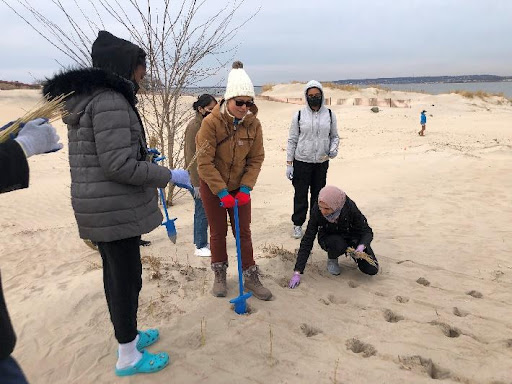Building Resilience from the Classroom to the Community

This blog post was written by contributors from the National Wildlife Federation: Emily Fano, Marya Fowler, Kath Race.
The United Nations’ February 2022 IPCC report on climate change underscores the urgent need to take immediate climate action. As part of our collective response, it's critical to equip future generations with the knowledge and tools needed to implement local climate resilience solutions, at both neighborhood and larger scales.
The RiSC program is currently funded by the National Oceanic and Atmospheric Administration (NOAA) and the Federal Emergency Management Agency.
The Student Climate Resilience Ambassadors program was originally funded by the EPA, with additional funding from H-E-B, the Alkek Foundation, the Duncan Fund and the Powell Foundation.
Two programs at the National Wildlife Federation, the Resilient Schools Consortium (RiSC) program in New York City and the Student Climate Resilience Ambassadors (SCRA) in Houston, focus on youth-led climate action and creating nature-based solutions to mitigate future climate impacts. Both programs rely on engaging students in fieldwork beyond the classroom to help forge intergenerational connections and build more climate-resilient communities.

Fast forward to March/April 2022, when students from nine partner schools planted 10,000 beachgrass culms to stabilize dunes along the shoreline in Coney Island—a community that was badly battered by Superstorm Sandy. This living shoreline is designed to help protect the surrounding homes and property from flooding and storm surges. In New York City, teams of students from the RiSC Program recently examined Coney Island’s ecological and social history. Based on their research, they created vignettes of the original shoreline as the Indigenous Lenape people would have seen it and compared it to today’s shoreline today. This assignment prompted students to question what it might take to restore it.
Their essential work continues both inside and outside the classroom as they further educate the community about the impacts of climate change. Students will create podcasts, conduct oral history interviews with local residents, and gather data about the public’s awareness of climate impacts, preparedness, and access to services.

Meanwhile, in Houston, one of the nation’s most vulnerable cities to flooding, students in the city are picking up shovels and taking action. The National Wildlife Federation’s Student Climate Resilience Ambassadors are busy learning about and implementing nature-based solutions that will likewise benefit their local communities. Student projects designed to mitigate flooding include rain gardens, bioswales, and pocket prairies. Like in New York City, students apply critical thinking skills and use mapping tools (such as NOAA’s coastal flood exposure mapper and local county flood maps) to investigate the problems specific to their community.
Equally important, students are learning about the connection between flooding and watershed health, particularly the impact of polluted water and flooding on vulnerable populations in the area. The SCRA program was developed with these most vulnerable communities in mind. Students conduct watershed audits, water quality testing, and campus and community vulnerability assessments to inform their action plans. In its third year now, students have completed nine nature-based campus resilience projects, participated in six community action days, and planted 3,500 native prairie plants and 500 native trees along local bayous. A former teacher running the program reports that watching the students grow as they take ownership of their projects has been truly rewarding.

In both cases, the work could not be done without on-the-ground partners. In Houston, this includes the City of Houston, Houston ISD, Houston Parks, and Recreation Department, Galveston Bay Foundation, the Student Conservation Association, and TBG Partners Houston and TNC Houston. In New York City, partners in the RiSC program include the American Littoral Society, NYC Parks, Coney Island Beautification Project, the NYC Department of Education, New York Sea Grant, the Science and Resilience Institute at Jamaica Bay, and Kid Power Academy.
Efforts to expand the important work of the RiSC program are ongoing by the National Wildlife Federation and its partners.








